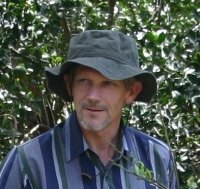Sunbirds I came across included olive-bellied (Nectarinia chloropygia), scarlet-chested (Nectarinia senegalensis), bronze (Nectarinia kilimensis), marico (Nectarinia mariquensis) and little purple-banded (Nectarinia bifasciata). Had particularly fine views of male bronze and marico sunbirds working their way up Leonotis stems as they breakfasted on nectar from the tubular orange flowers. Marico and little purple-banded can be difficult to distinguish from each other, and I have seldom if ever before seen both species on one outing.
Our principal bishop species here in town is the black bishop (Euplectes gierowii), and during breeding season it's not unusual to come across a male decked out in regal red, yellow and black, displaying in an area with long grass and shrubs. This morning I was surprised to see at least four and possibly six different males in full nuptial splendor, all in a fairly small area. I also noticed at female or two and some juveniles, evidence of some reproductive success this season.
Other highlights:
* Wire-tailed swallow (Hirundo smithii) collecting mud from a puddle margin for nest-building
* African green pigeon (Treron calva), a pair in a musasa (Sapium ellipticum) tree, one of them on a nest
* In the canary category, both African citril (Serinus citrinelloides) and yellow-fronted canary (Serinus mozambicus)
* Shrikes: brown-crowned tchagra (Tchagra australis) -- am used to encountering them outside of town, but this was the first instance for me in our neighborhood) -- and northern puffback (Dryoscopus gambensis)
* Red-faced cisticola (Cisticola erythrops)
* African blue flycatcher (Elminia longicauda)
* The African black kites (Milvus migrans) are back in force after their seasonal absence, and I also saw some of the first bronze-tailed starlings (Lamprotornis chalcurus) back in this area from their annual intra-Africa migration. If the bronze-tails return to roosting in the Markhamia and adjoining trees on the north side of our house as they did last year, our evenings and early mornings are about to become noticeably noisier!

No comments:
Post a Comment